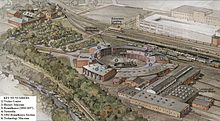Steamtown National Historic Site
All the buildings on the site are listed with the National Register of Historic Places as part of the Delaware, Lackawanna and Western Railroad Yard-Dickson Manufacturing Co.
[3][4] Most of the steam locomotives and other railroad equipment at Steamtown NHS were originally collected by F. Nelson Blount, a millionaire seafood processor from New England.
[6] The idea was derided by those who called the collection second-rate, the site's historical significance questionable, and the public funding no more than pork-barrel politics.
[9] By 1995, the National Park Service (NPS) had acquired Steamtown, USA, and improved its facilities at a total cost of $66 million.
Steamtown NHS is located within a working railroad yard and incorporates the surviving elements of the 1902 DL&W Scranton roundhouse and locomotive repair shops.
[10] Engines NKP #759, CN #47, New Haven Trap Rock Co. #43, and Rahway Valley #15 have operated at Steamtown, but not since the move to Pennsylvania.
[10] "Peppersass" No.1 from Mount Washington Cog Railway visited the Steamtown Scranton site during Railfest 2016, and revisited again during March 11 to 13, 2019.
The first order of business for the Steamtown Foundation was to acquire the Blount collection at North Walpole, and move it to property once owned by the Rutland Railroad, in Bellows Falls, Vermont.
One of Blount's corporations, the Green Mountain Railroad (GMRC), controlled the tracks that lay between Walpole, Bellows Falls and Chester, Vermont, which Steamtown was to use for its excursions.
[46] In addition, the steam excursions that Steamtown sponsored violated Vermont's pollution regulations, but the railroad was able to operate for several years under waivers issued by the state.
[53]Self-syndicated newspaper columnist Michael McManus once said that his goal in writing his weekly column was "to suggest answers to problems of the old industrial states.
[51] Moreover, the roof of the largest storage shed on the property had collapsed under heavy snow the previous winter, damaging several pieces of equipment.
[56] Asked by McManus to describe the value of the Steamtown collection, Jim Boyd, editor of Railfan & Railroad magazine, said, "Everything there is no longer obtainable anywhere, whether it is the "Big Boy" [Union Pacific No.
It is a significant part of America's past before the welder's torch is turned on the likes of the 1877 'Prince of Liege', the rare Union Pacific diamond stack, etc.
"But on May 24, Scranton signed a contract to get it, pledging to raise $2 million to cover the cost of moving 40 ancient steam engines and 60 cars, few of which are operable, and to create a museum.
In addition, while the tourists in Vermont had enjoyed the sights of cornfields, farms, covered bridges, a waterfall and a gorge on a Steamtown excursion,[62] the Scranton trip to Moscow, Pennsylvania, cut through one of the nation's largest junkyards, an eyesore described by Ralph Nader as "the eighth wonder of the world".
On November 23, 1991, an article in The New York Times said, "The provision for the park was inserted into a huge appropriations bill at a late-night meeting near the end of the legislative session in October 1986.
"[7] The article noted that "a number of historians and museum curators around the nation call Steamtown a second-rate collection of trains on a third-rate site.
They say that while such historic recreations have a place, the Federal Government should not be financing them simply because influential members of Congress want them for their districts.
"[7] It said that James M. Ridenour, director of the Park Service, said that Steamtown was among other projects that the agency neither needed nor wanted, adding that the same collection was rejected by them when it was still in Vermont because it "lacked historic importance".
Published on January 8, 1992, the letter argued that the statement, first made by a former Smithsonian curator, that "Steamtown was a second-rate collection on a third-rate site," was unfounded.
[9] Scranton and Panuska wrote, "The collection of 29 steam engines and 82 other railroad cars and equipment is the third largest in the country, the only one available for commemorating the industrialization of America in a historic setting.
"[9] They said that the 19th-century American Industrial Revolution was under-represented in the National Park System[9] and further said that Scranton is the only city in the Eastern United States with the vestiges of the era of industrialization (1840–1920) in plain sight, 40 acres in the middle of downtown, with car shops, locomotive shops, roundhouse, turntable, grand passenger station, a working yard, iron furnaces, passenger excursions — the whole works and a restored coal mine nearby.
This city [Scranton] was founded because of its iron ore and its ability to produce rails (previously imported from England), followed by its graduation to a coal and steel economy.
The passenger trains stopped decades ago, but one memory remains: the Lackawanna's elegant station, just up the street from Steamtown, completed in 1908 and converted into a hotel through a public-private partnership in 1983.
"[5] Len Barcousky, writing for the Pittsburgh Post-Gazette, described that history saying: "It was steam locomotives that unified the nation in the century between 1850 and 1950.
Maintained in giant roundhouses in a hundred cities like Scranton, the smoke-belching engines carried the people and the goods that made possible the Industrial Revolution.
[69] In November 1995, The New York Times printed a favorable review written by Supreme Court correspondent Linda Greenhouse, who had visited the site with her husband and daughter.
[70] From October 1 through 16, 2013, Steamtown was closed, along with the rest of the National Park system, as part of the United States federal government shutdown of 2013.
[75] On July 10, 1995, less than two weeks after the museum opened, two teen-aged boys were killed when they were struck by Steamtown's Canadian Pacific 2317, which was pulling a train with 575 passengers on an excursion trip to Moscow, Pennsylvania.



